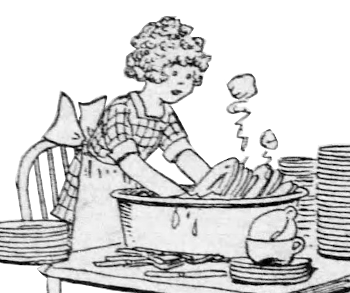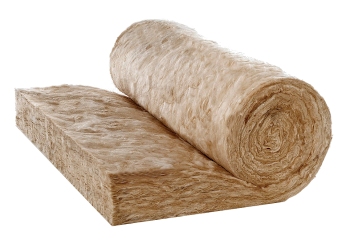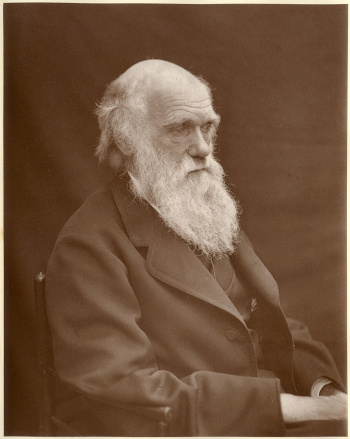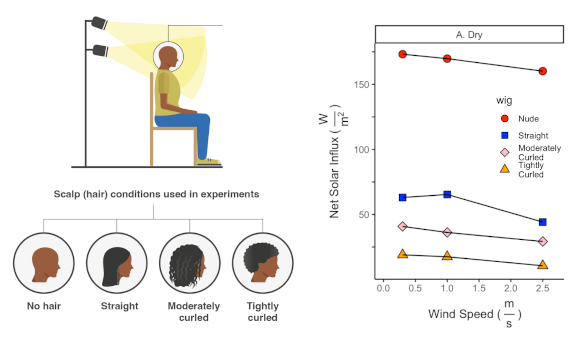Curly Hair
March 20, 2023
My
maternal grandmother was
Polish, and I would often visit her in her
cozy apartment on the second floor of a
two-family house. As she was making
tea for us, I would browse through the
Polish language weekly
newspaper she received in the
mail, trying to make sense of that
language. The 32
letters of the
Polish alphabet resemble the
Latin alphabet; so, how hard could that be? In fact, it was impossible, since Polish is not a
Latin-
Germanic language like
English. One interesting feature of that newspaper was the short
Little Orphan Annie cartoon, presented in Polish. Annie's most distinctive feature is her large ball of
curly hair. Curly hair in
humans may have
evolved as a means to
insulate our
overheated brain from the
environment.[1-2]

A portion of the first Little Orphan Annie comic strip from the New York Daily News, August 5, 1924, page 26. This shows Annie washing dishes in an orphanage.
This cartoon was created by Harold Gray (1894–1968), and it ceased publication in 2020.
(Edited portion of a Wikimedia Commons image.)
From a
physics perspective, the
spherical cow model for this
property can be found in
glass wool thermal insulation known to most
homeowners.[3]
Dry air at
room temperature has the very low
thermal conductivity of 2.6 x 10
-2 watt/
meter-
kelvin (W/m-K). The
glass fibers of the glass wool have a thermal conductivity of about 0.8 W/m-K, but the glass wool entraps air, and this results in a low overall thermal conductivity. The
physical process is explained by the watts per meter-kelvin
units of thermal conductivity. A watt, which is a
joule per
second, expresses the
rate of
energy loss, and this depends on the
temperature difference from one side of the thermal insulator to the other and its thickness.
Of course, thicker is better, and among the first things I did when my family moved into our present house was to add an additional four
inches of glass wool insulation above the existing three inches between the
ceiling joists. It was hard
work for someone who spent most of his time seated in front of a
computer display; but, the
hourly labor rate derived from subsequent
savings on
home heating cost was far beyond what I earned as a
scientist. Not so much of a concern then as it is now was my reduced contribution to
global warming.

A common sight to home builders - A roll of glass wool attic insulation.
Since people associate better quality with larger numbers, home insulation is tagged with an R-value. This number is essentially the inverse of the thermal conductivity for the specific thickness of the material.
(Image, a Knauf Insulation Rafter Loft Roll, licensed under a Creative Commons License. Click for larger image.)
Humans are unusual among
primates for not having
bodies covered with
fur. Our loss of fur happened about 1.6 million years ago as an
evolutionary adaptation to our change of
behavior to that of
animals traveling long distances in search of
food and
water.[4] We have, however, retained
hair atop our
heads, and a new
study of the possible reasons for retention of such hair has been
published in
bioRxiv.[1]
Research team members were from
Pennsylvania State University (State College, Pennsylvania), the
University of Southern California (Los Angeles, California),
Loughborough University (Loughborough, Leicestershire, England), and the
University of Sydney (Sydney, Australia).[1]
As we all have observed,
scalp hair type is variable between people, but the consequence of such variation has never been been studied.[1] Scalp hair, especially curly hair, may have evolved as a means of
thermoregulation.[2] The idea of hair insulating our heads from the cold seems obvious, and our
ancestors did live through an
ice age.[1] People with short hair, of the order of 5
millimeters lose heat more quickly than those with longer hair, of the order of 100-130 millimeters.[1] However, hair will also act to insulate from heat.[1]
Hominids with their hairless bodies and
bipedal posture may have needed to evolve by keeping scalp hair to protect our large brains from
solar radiation.[1-2] A 2010 study found that
bald heads absorb more heat.[2]

Who better to illustrate an article with mentions of evolution and baldness than Charles Darwin (1809-1882). Another bald scientist is Muppet character, Dr. Bunsen Honeydew.
This is a photograph of Charles Darwin taken around 1874 by his son, Leonard Darwin (1850–1943), also noted as a mentor of the preeminent statistician, Ronald Fisher (1890-1962).
(Wikimedia Commons image. Click for larger image.)
The research team designed an
experiment to examine the potential evolutionary advantage of human scalp hair and the variation of its
morphology. The experiment used a
mannequin wearing human hair
wigs in a
temperature and
humidity-controlled environment at different
wind speeds.[1-2] Solar radiation was simulated with a
lamp, and
data were collected for
convective,
radiative, and
evaporative heat fluxes to and from the scalp.[1] The authors state that these experiments are the first of their type.[2]

Experimental setup and results for the influence of solar radiation on dry skin for various hair types. The types are no hair, straight, moderately curled, and tightly curled. The conditions were 30 °C, and 60% relative humidity. (Left, a portion of fig. 1 from ref. 1; and right, a portion of fig. 3 from ref. 1.[1] Licensed under a Creative Commons License. Click for larger image.)
It was found the bald mannequin absorbed a considerably greater amount of heat, and curly hair resulted in significantly less absorbed heat.[2] More tightly curled hair offered increased protection against heat gain from solar radiation.[1] The results indicate that any type of head covering reduces heat gain from the Sun.[2] It appears that scalp hair evolved in response as a defense against over heating after our species' evolution of upright posture and large brains.[2] Decreased
sweating would extend how long an individual could engage in
strenuous physical activity before needing water.[1]
As the researchers write,
"The emergence (or retention) of scalp hair may have struck an optimal balance between maximizing heat loss across the large surface area of the body and minimizing solar heat gain on the small surface area of the scalp, directly over the brain."[1]
References:
- Tina Lasisi, James W Smallcombe, W. Larry Kenney, Mark D. Shriver, Benjamin Zydney, Nina G. Jablonski, and George Havenith, "Human scalp hair as a thermoregulatory adaptation," bioRxiv, January 25, 2023, doi: https://doi.org/10.1101/2023.01.21.524663. Supplementary material here.
- Carly Cassella, "Cool New Experiment Explains Why We Evolved Curly Hair," sciencealert, February 17, 2023.
- Games Slayter, "Fibrous products and method and apparatus for producing same," US Patent No. 3,012,923, December 12, 1961 (Via Google Patents).
- Nina G. Jablonski, "The Naked Truth: Why Humans Have No Fur," Scientific American, February 1, 2010.
Linked Keywords: Grandparent; maternal grandmother; Poland; Polish; cozy; apartment; two-family; house; tea; Polish language; newspaper; mail; language; letter (alphabet); Polish alphabet; resemble; Latin alphabet; Latin; Germanic language; English language; Little Orphan Annie; cartoon; curly hair; human; evolution; evolve; thermal insulation; insulate; human brain; environment (biophysical); comic strip; New York Daily News; dishwashing; washing dishes; orphanage; cartoon; Harold Gray (1894–1968); publishing; publication; Wikimedia Commons; physics; spherical cow model; physical property; glass wool; owner-occupancy; homeowner; arid; dry; atmosphere of Earth; air; room temperature (scientific use); thermal conductivity; watt; meter; kelvin; glass fiber; physics; physical process; units of measurement; joule; second; rate (mathematics); energy; temperature gradient; temperature difference; inche; ceiling joist; job; work; computer monitor; computer display; wage; hourly labor rate; savings; central heating; home heating; cost; scientist; global warming; home construction; home builder; rolling; roll; attic; building insulation; quality (business); number; building insulation; home insulation; R-value (insulation); multiplicative inverse; material; Knauf Insulation Rafter Loft Roll; Creative Commons License; human; primate; human body; fur; evolutionary adaptation; human behavior; animal; food; water; hair; head; scientific method; study; scientific literature; publish; bioRxiv; research; Pennsylvania State University (State College, Pennsylvania); University of Southern California (Los Angeles, California); Loughborough University (Loughborough, Leicestershire, England); University of Sydney (Sydney, Australia); scalp; thermoregulation; ancestor; ice age; millimeter; Hominidae; Hominids; bipedalism; bipedal; spinal posture; solar irradiance; solar radiation; hair loss; bald; evolution; baldness; Charles Darwin (1809-1882); scientist; The Muppets; character (arts); Dr. Bunsen Honeydew; photograph; son; Leonard Darwin (1850–1943); mentor; statistician; Ronald Fisher (1890-1962); experiment; morphology (biology)">morphology; mannequin; wig; temperature; humidity; wind speed; lamp (electrical); data; convection; convective; radiative cooling; evaporation; evaporative; heat flux; sunlight; dry; skin; hair; °C; relative humidity; perspiration; sweating; strenuous; physical activity.